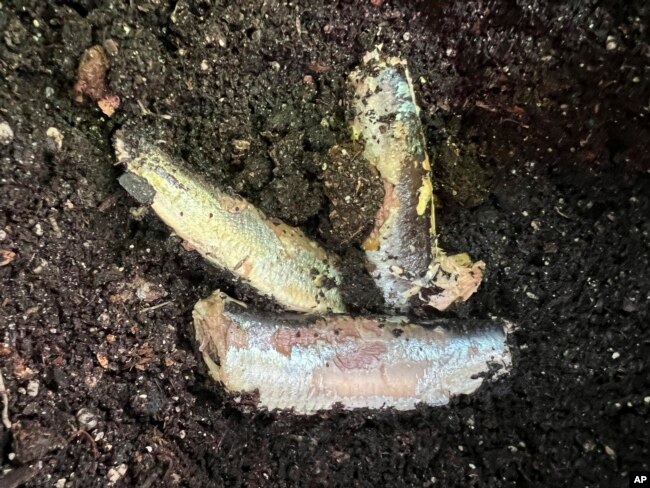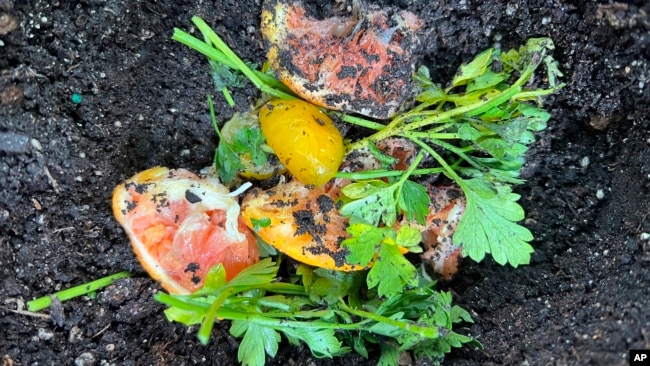堆肥を作ろう!!
化学肥料は体にも環境にもよくありません!!
さぁ、堆肥を作りましょう!!!の記事です。
VOAで英語を学びましょう!!
きっと、ここに出てくる化合物は覚えて有益!!
肥料を買うな! それは身近なところにある(和訳)
Don’t Buy Fertilizer! It Is All Around You.
July 05,2022
あらゆるもののコスト –燃料費から食費まで –が 世界的に上昇しているようです。ですから、自分たちの食べ物を育てることは、お金を節約する良い方法なのです。
しかし、ガーデニングの材料費も高騰しています。
植物の専門家であるジェシカ・ダミアーノ氏は、AP通信でガーデニングについて記事を書いています。最新の記事では、彼女は肥料代の節約について書いています。彼女は、家庭菜園をする人に、自分で肥料を作ることを提案しています。
すべての植物は栄養分を必要とします。必要な栄養素は、ほとんどの土壌に自然に存在しています。しかし、時間が経つにつれて、それらは使い果たされてしまいます。ですから、植物が私たちの食卓に上る野菜や果物を作るためには、時折、土に栄養分を加える必要があるのです。
そこで登場するのが肥料です。
ほとんどの肥料には、三大栄養素が含まれています:窒素、リン、そしてカリウムです。(これは、多くは肥料の容器に書かれているN-P-K比で表示されます。)ダミアーノ氏は、この3つの働きを説明しています。Nitrogen窒素は、植物がエネルギーを緑色の葉の成長に変えるのを助け、Phosphorusリンは根や果実、花の発育を助けます。そしてpotassiumカリウムは、植物の健康全般をサポートします。
※Nitrogen :【náitrədʒən】
Phosphorus:【fɑ́sfərəs】
Potassium:【pətǽsiəm】
多くの肥料には、カルシウムやマグネシウムなどの副栄養素も含まれています。また、鉄、銅、ホウ素、マンガン、亜鉛などの微量栄養素を含んでいることもあります。
※ Iron :【άɪɚn】
Copper:【kˈɔpə】
Boron:【bɔ́ːrɑn】
Manganese:【mˈæŋgənìːz】
Zinc :【zíŋk】
これらの栄養素はすべて、植物にとって最良の生育条件を作り出すために必要なものです。
ここで朗報があります。家庭菜園では、お金をかけずに高品質の栄養素を植物に与える方法がたくさんあるのです。
草を刈る
刈り草を考えてみましょう。刈り取った草を芝生の上に置いておくと、肥料が不要になる場合があります。
草が分解されると、土の中に窒素が放出されます。これが、芝生が成長し続けるのに役立つのです。ただし、ダミアーノ氏はこんな警告をしています。刈りたての草を庭の花壇には使わないでください。植物が焼けてしまいます。
堆肥は土壌に最適
堆肥は、土に加えることができる最高のものだと彼女は言います。
堆肥は土の中の水分の量を調節するのに役立ちます。乾燥した土が湿った状態に保たれるのです。厚い土、つまり粘土質の土の水捌けをよくしてくれるのです。また、堆肥は土に栄養を与えます。
ダミアーノ氏は、植木鉢や植え穴に堆肥をたくさん使うようアドバイスしています。彼女は、堆肥を根覆いの代わりに使うことを勧めています。(根覆いは土の上に敷くものです。)
堆肥を作るには、果物や野菜のくずを集めればいいのです。肉類、乳製品、油脂類は入れないでください。生ゴミは台所にあるボウルに入れておくとよいでしょう。ボウルがいっぱいになったら、庭の土に直接埋めてください。生ゴミが分解されると、栄養が加わります。
ただし、少なくとも25~30センチメートルの深さに埋めるようにしてください。そうすれば、お腹を空かせた野生動物に掘り起こされる心配がありません。また、植物から数センチ離して埋めてください。根を傷めないようにするためです。
魚の肥料
多くの園芸家は、魚の肥料で植物を扱っています。窒素、リン、カリウム、カルシウム、マグネシウム、硫黄、ナトリウムなどの栄養素が含まれています。そして、コストがかかる可能性があります。そこでダミアーノ氏は、魚の部分を庭の土の奥深く--やはり25〜30センチメートルの深さに埋めることを提案しています。
また、水を張った密閉容器に魚のくずを入れれば、自分で魚の肥料を作ることもできます--約19リットルです。1カ月ほど放置しておきます。その後、液体を抜いて、植物の水やりに使います。ただし、塩分を含んだ魚の加工品は使わないでください。塩分の取りすぎは、土や植物を傷めることになります。
家の中の余ったものを利用する
あなたは釣りをする人ですか?もしそうなら、釣った魚の切れ端を使うことができます。そうでない場合は、近所の魚屋さんが、魚の切れ端や頭を譲ってくれたり、安価で売ってくれるかもしれません。
あなたは魚を飼っていますか?生け簀の水も植物に有効です。この水には、窒素などの栄養分が豊富に含まれています。
野菜を水煮していますか?もしそうなら、保存してください。その水にはビタミンやミネラルが含まれていて、庭の手入れに役立ちます。
そして、ゆで卵の水にはカルシウムがたっぷり含まれています。これは特にトマトやピーマンに有効です。ただ、植物に使う前に、水を室温まで冷ましてから使ってくださいね。
庭の石灰を買う代わりに、卵の殻を使うこともできます。どちらも炭酸カルシウムでできています。卵の殻を十分に乾燥させます。そして、細かく砕きます。その殻を庭の土に混ぜます。バナナの皮も同じように使えます。カリウムがたくさん含まれていて、植物に良いのです。
Don’t Buy Fertilizer! It Is All Around You.
The cost of everything – from fuel to food – seems to be rising around the world. So, growing our own food is a good way to save money.
However, the cost of gardening materials has also been rising.
Plant expert Jessica Damiano writes about gardening for the Associated Press. In her latest story, she writes about saving money on fertilizer. She suggests that home gardeners make their own.
All plants require nutrients. Necessary nutrients exist naturally in most soils. But over time, they get used up. So, nutrients need to be added to the soil from time to time for plants to produce fruits and vegetables for our meals.
This is where fertilizers come in.
Most fertilizers contain three primary nutrients: nitrogen, phosphorus, and potassium. (This is often represented by the N-P-K ratio on fertilizer containers.) Damiano explains how the three work. Nitrogen helps the plant turn its energy into green, leafy growth. Phosphorus helps the development of roots, fruits, and flowers. And potassium helps the plant’s overall health.
Many fertilizers also have secondary nutrients, like calcium and magnesium. They sometimes have micronutrients such as iron, copper, boron, manganese, and zinc.
All these nutrients are necessary for creating the best growing conditions for a plant.
Here is some good news: There are many ways that home gardeners can save money while providing their plants with high-quality nutrients.
Cut grass
Consider cut grass. If you leave cut grass on the lawn, you may not need fertilizer.
As grass breaks down, it releases nitrogen into the soil. This will help grass to continue to grow. However, Damiano gives this warning: Do not use fresh cut grass in garden beds. It will burn your plants.
Compost is best for soil
Compost, she says, is the best thing you can add to soil.
Compost helps to control how much water stays in the soil. It keeps dry soil wet. It can help thick dirt, or clay, drain water. Compost also adds nutrients to the soil.
Damiano advises to use a lot of compost in plant beds or planting holes. She suggests using compost in place of mulch. (Mulch is placed on top of the soil.)
To make your own compost, simply collect fruit and vegetable scraps. Do not add meat, dairy, or fats. You can keep the food scraps in a bowl in your kitchen. Whenever it fills up, bury the material directly in the garden soil. As the scraps break down, they add nutrients.
Just be sure to bury them at least 25 to 30 centimeters deep. This will keep hungry wildlife from digging them up. And bury the scraps several centimeters from the plants. This will avoid damaging roots.
Fish fertilizer
Many gardeners treat their plants with fish fertilizer. It contains nitrogen, phosphorus, potassium, calcium, magnesium, sulfur, and sodium, among other nutrients. And it could be costly. So, Damiano suggests burying fish parts deep in the garden soil -- again 25 to 30 centimeters deep.
You can also make your own fish fertilizer by putting fish scraps in a closed container of water -- about 19 liters. Leave it for about a month. Then drain the liquid and use it to water plants. However, do not use processed fish that has added salt. Too much salt can damage the soil and your plants.
Use leftover materials from around your house
Are you someone who fishes? If so, you can use scraps from the fish you catch. If not, your local fish seller, called a fishmonger, might give away — or sell at low cost — scraps and heads.
Are you a fish owner? Plants can also be helped from used fish-tank water. This water is rich in nitrogen and other nutrients.
Do you cook vegetables in water? If so, save it! The water is filled with vitamins and minerals that could help your garden.
And water from boiled eggs is full of calcium. This is especially useful for tomatoes and peppers. Just make sure to let the water cool to room temperature before using on your plants.
You can even use eggshells instead of buying garden lime. Both are made of calcium carbonate. Dry out the egg shells thoroughly. Then break them up into tiny pieces. Add the small pieces to your garden’s soil. The same can be done with banana peels. They are full of potassium and good for plants.
Words in This Story
garden – n. a piece of ground in which fruits, flowers, or vegetables are grown
primary –adj. first in order of time or development
ratio – n. the relationship in number or quantity between two or more things
lawn – n. ground (as around a house or in a garden or park) that is covered with grass and is cut regularly
compost – n. a mixture that consists largely of decayed organic matter and is used for fertilizing and conditioning land
mulch – n. a material (as straw or bark) spread over the ground especially to protect the roots of plants from heat or cold, to keep soil moist, and to control weeds
scrap –n. a piece of something that is usually thrown away
drain – v. to remove liquid from something

